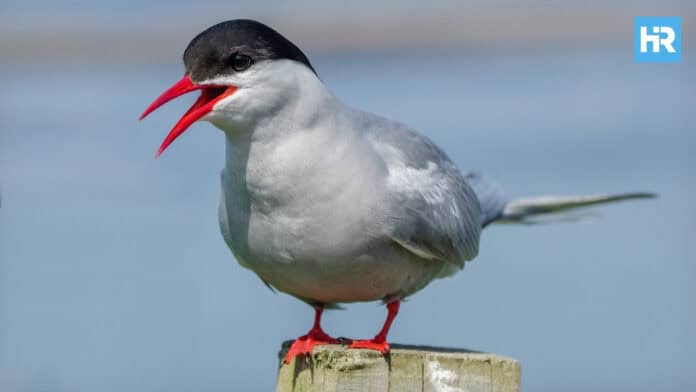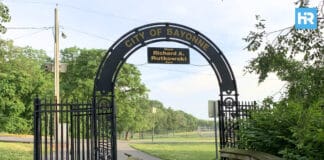Hoboken, a city along the Hudson River, is now the center of a growing movement to protect the Common Tern, a threatened seabird that has nested on Pier 11 for over ten years. This bird, once nearly wiped out for its feathers during the Victorian era, is facing new dangers. Its home on the pier was recently blocked by nets, which led to the death of one tern.
This incident caught the attention of local birders, especially Jeffrey Train, a teacher and conservation advocate. In response, he formed a group called Our Tern. Their mission is to protect the terns and teach others about the importance of conservation. With the help of Hoboken officials and the New Jersey Department of Environmental Protection, the nets were removed.
Now, the focus is on creating a safe space for the birds to nest. The city is looking into building a new pier or artificial island in Weehawken Cove, where terns and other birds can nest without being disturbed. This idea was inspired by a city in Hawaii that chose the White Tern as its official bird. People from Mexico have also reached out to learn how they can protect their own bird populations.
Meanwhile, Hoboken is using art and public events to get more people involved.
- Hoboken is running a Tern Parade from April 1 to June 1 with 30 businesses displaying tern decoys to support the threatened Common Tern.
- Our Tern is working with the city to build a long-term nesting island in Weehawken Cove to protect the birds.
- The Raptor Trust treats over 6,000 injured birds annually and operates New Jersey’s main bird rehabilitation center.
The Tern Parade Turns Conservation into Community Celebration
To raise awareness, the city launched the Hoboken Tern Parade. This event runs from April 1 to June 1, 2025, and features 30 businesses and organizations displaying colorful tern decoys made by local artists. These decoys are being shown in shops such as Fiore’s House of Quality, Lepore’s Famous Chocolates, and Little City Books.
After June 1, all the decoys will be moved to the Hoboken Public Library until June 13, followed by a public viewing at a waterfront event on June 15, and finally, a display at the Hoboken Historical Museum. After that, they will be auctioned off, with the money going to protect the terns.
Throughout the spring, many Hoboken businesses are also hosting special events:
- Every Wednesday afternoon in May, Mr. Train will lead bird walks at the library and teach kids about birds using jokes and facts.
- At Mario’s Pizza, visitors can try a special RigaTERNi Pizza
- Dozzino offers crafts where people can make their own tern ornaments.
- Tunes, a local music spot, is setting up a “Tern Table” where visitors can request songs.
- On June 11, Fleet Feet hosts a “Turn Out for Terns” fun run, with a stop to view the live tern colony.
- The event ends on Saturday, June 14, at Schmitty’s Pub, with music by Dave Lambert, voting for the best tern decoy, and prize announcements for the scavenger hunt.
The final weekend of the event will also feature a public display of the tern decoys along the 12th Street Public Pier, next to the actual tern nesting site.
Raptor Trust in Millington Treats Over 6,000 Birds Annually
While Hoboken celebrates the tern, a bird care center in Millington continues the day-to-day work of saving injured birds. The Raptor Trust has become New Jersey’s top wild bird rehabilitation center, treating over 6,000 birds every year.
It began in 1951 when Diane Soucy asked her husband, Len, for a bird feeder. Over time, their interest grew from simple birdwatching into full-time care for birds. Their son, Chris Soucy, now runs the center, which sits on 14 acres beside the Great Swamp National Wildlife Refuge.
Soucy says that as a kid, his house was full of birds—owls in the bathroom, robins in the laundry room, and cardboard boxes everywhere. Though he wanted a normal childhood, he later came to value the work his parents had done.
Today, the Raptor Trust has a fully equipped animal hospital with X-rays, ultrasounds, eye exams, and surgery. They release the birds that are fit for the wild and keep the rest that can’t survive alone.
For example, there are birds with injured wings or blindness that makes them unable to hunt. And then you have the birds that were imprinted by humans and no longer know how to live in the wild.
Each year, the Trust spends thousands of dollars on food. They buy crickets, berries, seeds, fish, and mice. Last year alone, they spent $67,000 on frozen mice and purchased 750,000 insects. The swans and geese eat grass, so the staff mows the lawn and feeds it to them.
The center runs with the help of 20 staff members, 100 volunteers, and interns. They feed young birds by hand and keep the aviaries in good shape. One new aviary, the size of a garage, costs about $35,000 to build.
Soucy says a common danger is sticky tape placed around trees to catch spotted lanternflies. Birds often get stuck, injure themselves trying to escape, and some die. One year, they treated 100 birds injured by tape.
Fishing wire, plastic bags, and sports nets also hurt birds. People may not realize how these materials harm wildlife, but Soucy sees it every day.
He explains that if you find a bird that seems injured or unable to fly, it’s important to look at the situation. Often, a young bird’s parents are nearby. If there’s no immediate threat like a cat, it’s best to leave the bird alone. But if the bird is clearly hurt, or if it’s a larger bird like a hawk, the Raptor Trust can help.
The Raptor Trust is free to visit and open for self-guided tours daily from 9 a.m. to 4 p.m.. If you find an injured bird, call 908-647-2353.






